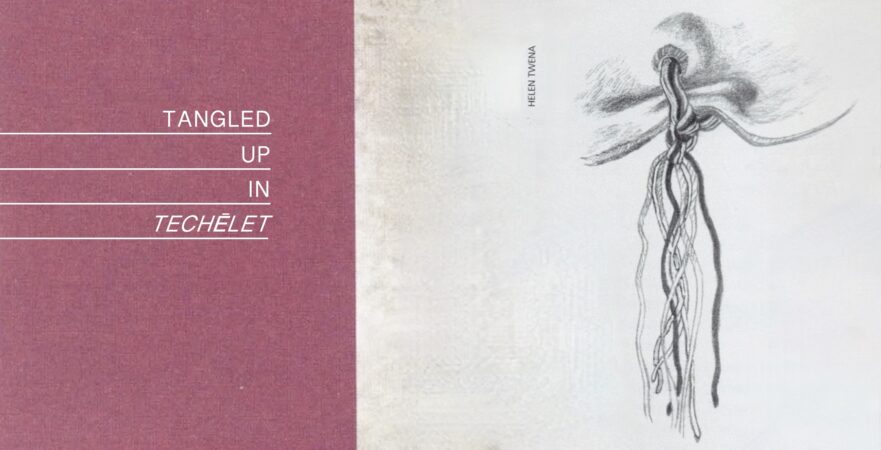How to cite this article: Joshua N. Tilton, “Tangled up in Techēlet: Tzitzit (Ritual Tassels) in the Time of Jesus,” Jerusalem Perspective (2023) [https://www.jerusalemperspective.com/27237/].
| Rather listen instead? |
| JP members can click the link below for an audio version of this essay.[*]
Paid Content
Premium Members and Friends of JP must be signed in to view this content. If you are not a Premium Member or Friend, please consider registering. Prices start at $5/month if paid annually, with other options for monthly and quarterly and more: Sign Up For Premium  |
The wearing of tzitzit (ritual tassels) on the four corners of one’s garment is a Jewish custom enjoined by Scripture:
וַיֹּאמֶר יְהוָה אֶל־מֹשֶׁה לֵּאמֹר׃ דַּבֵּר אֶל בְּנֵי יִשְׂרָאֵל וְאָמַרְתָּ אֲלֵהֶם וְעָשׂוּ לָהֶם צִיצִת עַל־כַּנְפֵי בִגְדֵיהֶם לְדֹרֹתָם וְנָתְנוּ עַל־צִיצִת הַכָּנָף פְּתִיל תְּכֵלֶת׃ וְהָיָה לָכֶם לְצִיצִת וּרְאִיתֶם אֹתוֹ וּזְכַרְתֶּם אֶת־כָּל־מִצְוֹת יְהוָה וַעֲשִׂיתֶם אֹתָם וְלֹא־תָתֻרוּ אַחֲרֵי לְבַבְכֶם וְאַחֲרֵי עֵינֵיכֶם אֲשֶׁר־אַתֶּם זֹנִים אַחֲרֵיהֶם׃ לְמַעַן תִּזְכְּרוּ וַעֲשִׂיתֶם אֶת־כָּל־מִצְוֹתָי וִהְיִיתֶם קְדֹשִׁים לֵאלֹהֵיכֶם׃ אֲנִי יְהוָה אֱלֹהֵיכֶם אֲשֶׁר הוֹצֵאתִי אֶתְכֶם מֵאֶרֶץ מִצְרַיִם לִהְיוֹת לָכֶם לֵאלֹהִים אֲנִי יְהוָה אֱלֹהֵיכֶם׃
And the LORD spoke to Moses saying, “Speak to the children of Israel and say to them that they must make themselves tzitzit on the corners of their garments for their generations. And they shall place on the tzitzit of the corner a blueish-purple strand. And it shall be for you for a tzitzit so that you may see it and remember all the LORD’s commandments and do them and not stray after your heart or after your eyes which you lust after. In order that you may remember and do all my commandments and be holy to your God. I am the LORD your God who brought you out from the land of Egypt to be your God. I am the LORD your God.” (Num. 15:37-41)
גְּדִלִים תַּעֲשֶׂה־לָּךְ עַל־אַרְבַּע כַּנְפוֹת כְּסוּתְךָ אֲשֶׁר תְּכַסֶּה־בָּהּ
Twisted cords you shall make for yourself on the four corners of your covering with which you are covered. (Deut. 22:12)
Premium Members and Friends of JP must be signed in to view this content.
If you are not a Premium Member or Friend, please consider registering. Prices start at $5/month if paid annually, with other options for monthly and quarterly and more: Sign Up For Premium
- [1] Cf. Henry George Liddell, Robert Scott, and Henry Stuart Jones, A Greek-English Lexicon (9th ed.; Oxford: Clarendon, 1968), 1840. ↩
- [2] In Ezek. 8:3 צִיצִת refers to a lock of hair. ↩
- [3] See t. Men. 9:16: תכלת אין כשרה אלא מן החלזון הביא שלא מן החלזון פסולה (“The blueish-purple strand is not valid unless it comes from the murex snail. If it did not come from the murex snail, it is not valid”). See also the baraita in b. Men. 44a: ת″ר חלזון זהו גופו דומה לים וברייתו דומה לדג ועולה אחד לשבעים שנה ובדמו צובעין תכלת לפיכך דמיו יקרים (“Our rabbis taught: The murex: its color is like the sea and its shape is like a [shell]fish, and it surfaces once in seventy years, and with its blood they dye techēlet. Therefore its blood is expensive”). Both the rabbinic sages and Josephus refer to the dye coming from the snail’s blood. ↩
- [4] See Lloyd B. Jensen, “Royal Purple of Tyre,” Journal of Near Eastern Studies 22.2 (1963): 104-118, esp. 106. ↩
- [5] See F. S. Bodenheimer, Animal Life in Palestine: An Introduction to the Problems of Animal Ecology and Zoogeography (Jerusalem, 1935), 469-470; Oded Borowski, Every Living Thing: Daily Use of Animals in Ancient Israel (Walnut Creek, Calif.: AltaMira, 1998), 177-180. ↩
- [6] See Benjamin G. Wright III, “Three Jewish Ritual Practices in Aristeas §§158-160,” in Heavenly Tablets: Interpretation, Identity and Tradition in Ancient Judaism (ed. Lynn LiDonnici and Andrea Lieber; Leiden: Brill, 2007), 11-29, esp. 11. ↩
- [7] Text and translation according to Moses Hadas, ed. and trans., Aristeas to Philocrates (Letter of Aristeas) (Harper & Bros., 1951; repr., Eugene, Or.: Wipf and Stock, no date), 162-163. ↩
- [8] On this principle, see H. Guggenheimer, trans., Seder Olam: The Rabbinic View of Biblical Chronology (New York: Rowman and Littlefield, 2005), 6 n. 5. ↩
- [9] Cf. Masechet Tzitzit, which states:
מצות ציצית, בית שמאי אומרים ארבע חוטין של ארבע אצבעות, ובית הלל אומרים שלש חוטין של שלש אצבעות
The commandment to wear tzitzit: Bet Shammai say it requires four strands of four fingers’ breadth in length. But Bet Hillel say it requires three strands of three fingers’ breath in length. (Masechet Tzitzit §3 [Seven Minor Tractates, ed. Higger, 51])
See also Sifre Deut. §234 (ed. Finkelstein, 266), which, however, is at odds with Sifre Num. §115, b. Men. 41b and Masechet Tzitzit §3. ↩
- [10] Danby (798) equated a fingerbreadth with 2.33 cm, while Blackman (1:18) measured a fingerbreadth at 2.06-2.19 cm. See Herbert Danby, trans., The Mishnah: Translated from the Hebrew with Introduction and Brief Explanatory Notes (Oxford: Oxford University Press, 1933); Philip Blackman, trans., Mishnayoth (7 vols.; London: Mishnah Press, 1951-1956). ↩
- [11] For an introduction to the Jewish concept of ritual purity, see Joshua N. Tilton, “A Goy’s Guide to Ritual Purity,” Jerusalem Perspective (2014) [https://www.jerusalemperspective.com/12102/]. ↩
- [12] On the possibility that the tassels depicted on the corners of the mantles of certain individuals portrayed in the Dura-Europos synagogue paintings were tzitziyot, see Carl H. Kraeling, The Synagogue: The Excavations at Dura-Europos Conducted by Yale University and the French Academy of Inscriptions and Letters Final Report VIII, Part I (New York: Ktav, 1979), 81-82, esp. 81 n. 239. ↩
- [13] Yigael Yadin, The Finds from the Bar Kokhba Period in the Cave of Letters (Jerusalem: Israel Exploration Society, 1963), 182-187. ↩
- [14] And cf. the baraita concerning the murex in b. Men. 44a (quoted above), in which the mollusk is regarded as exceedingly rare. According to Pliny the Elder (Nat. hist. 9:63 §136-137), trade in murex snails greatly expanded in the first century B.C.E., which may have led to overfishing. ↩
- [15] See Shmuel Safrai, “Religion in Every Day Life,” in The Jewish People in the First Century (ed. Shmuel Safrai and Menahem Stern; 2 vols.; CRINT I.1-2; Amsterdam: Van Gorcum; Philadelphia: Fortress, 1976), 2:793-833, esp. 797; Jacob Milgrom, The JPS Torah Commentary: Numbers במדבר (Philadelphia: Jewish Publication Society, 1990), 412. ↩
- [16] See Masechet Tzitzit §1 (ed. Higger, Seven Minor Tractates, 50): טלית שהוא מכסה ראשו ורובו חייבת בציצית (“A cloak with which he [i.e., the wearer—JP] can cover his head and the majority of his body is obligated to have tzitzit”). ↩
- [17] See Safrai, “Religion in Every Day Life,” 798; Milgrom, The JPS Torah Commentary: Numbers במדבר, 410. ↩
- [18] See Yadin, The Finds from the Bar Kokhba Period in the Cave of Letters, 209; Lucille A. Roussin, “Costume in Roman Palestine: Archaeological Remains and Evidence from the Mishnah,” in The World of Roman Costume (ed. Judith Lynn Sebesta and Larissa Bonfante; Madison: University of Wisconsin Press, 1994), 182-190, esp. 184. ↩
- [19] Cf. m. Meil. 5:1: לָבַּשׁ בֶּחָלוּק כִּיסָה בַטַּלֵּית (“he dressed in a tunic and covered in a mantle”); t. Toh. 8:13: היה לבוש חלוק ועטוף בטלית (“A person who was dressed in a tunic and wrapped in a mantle...”); Mechilta de-Rabbi Ishmael, Kaspa §1 (ed. Lauterbach, 2:460): כי היא כסותה לבדה זו טלית היא שמלתו לעורו זו הלוק (“For it [i.e., a garment taken in pledge—JP] is his only covering [Exod. 22:26]—this is the mantle. It is the garment for his skin [Exod. 22:26]—this is the tunic”). ↩
- [20] Sifre Num. §115. ↩
- [21] See Avigail Sheffer and Hero Granger-Taylor, “Textiles from Masada—A Preliminary Selection,” in Masada IV: The Yigael Yadin Excavations 1963-1965 Final Reports (Jerusalem: Israel Exploration Society, 1994), 149-255, esp. 159-160, 238. ↩
- [22] Yadin, The Finds from the Bar Kokhba Period in the Cave of Letters, 221. ↩
- [23] Although the practice was not uniform. Cf. Semaḥot 12:11; Baraitot Me-Avel Rabati 3:15; Masechet Tzitzit §9. Jodi Magnes (Stone and Dung, Oil and Spit: Jewish Daily Life in the Time of Jesus [Grand Rapids: Eerdmans, 2011], 112) maintains that Semaḥot 12:11 refers only to the removal of the blueish-purple strand, but it is more likely that תכלת is used there as a synechdoche for ציצית (cf. the story about Rabbi Yonatan in b. Ber. 18b). ↩
- [24] Pace Magnes, Stone and Dung, Oil and Spit, 112-113. ↩
- [25] See Milgrom, The JPS Torah Commentary: Numbers במדבר, 412. ↩
- [26] Safrai (“Religion in Every Day Life,” 798) dated this ruling to ca. 70 C.E. ↩
- [27] Sifre Num. §115 opens with the statement אף הנשים במשמע (“Even women are intended [in the commandment to wear tzitzit]”; ed. Horovitz, 124). Similarly, a baraita in the Talmud states: ת″ר הכל חייבין בציצית כהנים לוים וישראלים גרים נשים ועבדים (“Our rabbis taught: Everyone is obligated to wear tzitzit: priests, Levites and Israelites, proselytes, women and slaves”; b. Men. 43a). ↩
- [28] See LSJ, 990. ↩
- [29] Cf. David N. Bivin, “Jesus and the Oral Torah: The Hem of His Garment,” under the subheading “Hebrew to Greek.” ↩
- [30] See Robert L. Lindsey, A Hebrew Translation of the Gospel of Mark (2d ed.; Jerusalem: Dugith, 1973), 111 (Mark 6:56). ↩
- [31] See David N. Bivin, “The New International Jesus,” Jerusalem Perspective 56 (1999): 20-24 [https://www.jerusalemperspective.com/5197/]. Translations consulted include:
- Charles Cutler Torrey's The Four Gospels: A New Translation was published by Hodder & Stoughton in 1934.
- J. B. Phillips' The New Testament in Modern English was published by The Macmillan Company in 1958.
- The Holy Bible: New Century Version was published by Word Publishing in 1987.
- Eugene H. Peterson's The Message: The New Testament, Psalms and Proverbs was published by NavPress in 1993.
- The Good News Bible: Today's English Version was published by Thomas Nelson in 1976.
- The New English Bible was published jointly by Oxford University Press and Cambridge University Press in 1961.
- Charles B. Templeton's Jesus: The four Gospels, Matthew, Mark, Luke and John, combined in one narrative and rendered in modern English was published by Simon and Schuster in 1973.
↩



